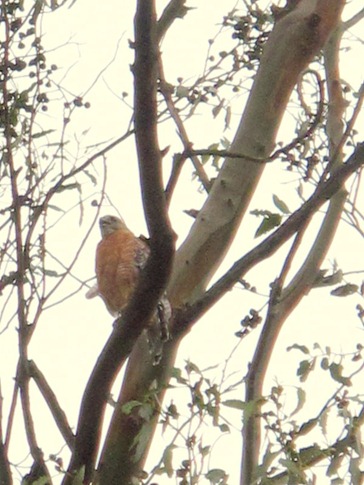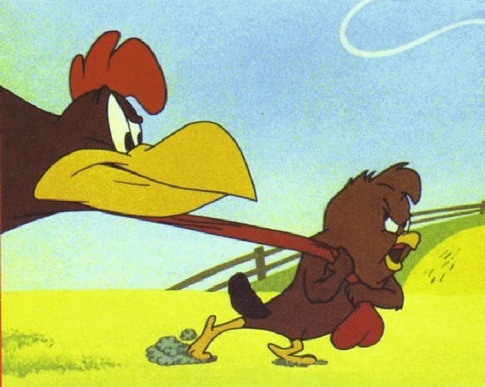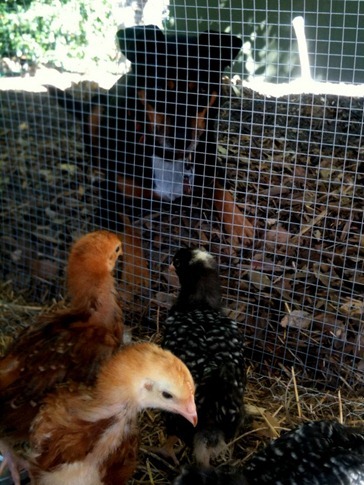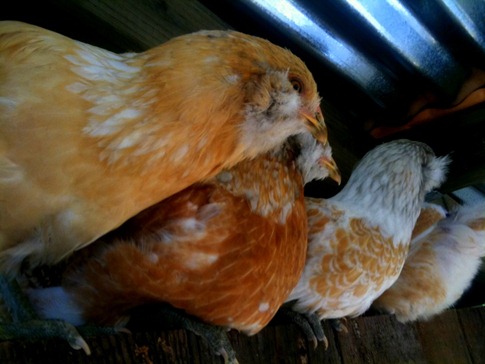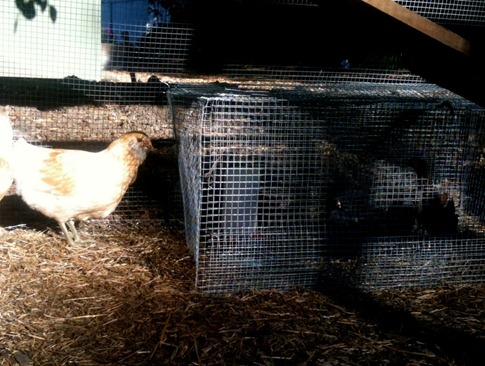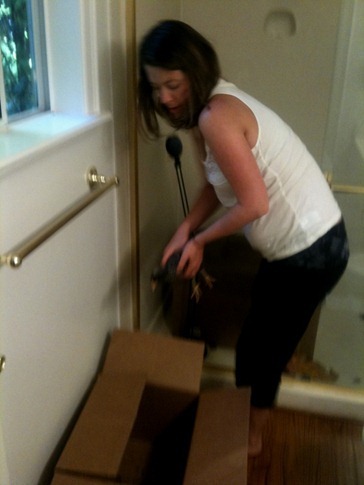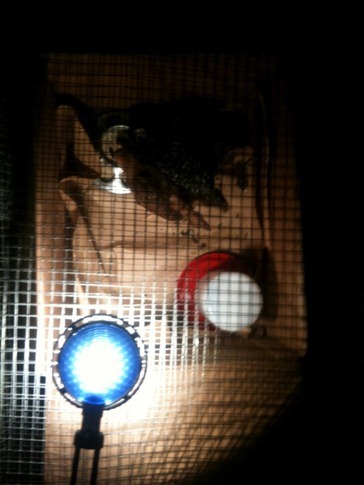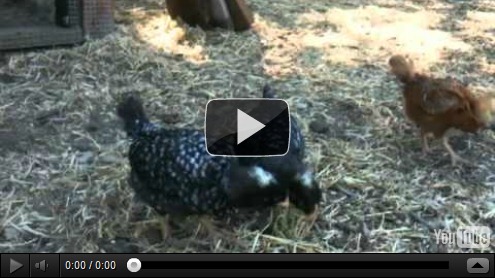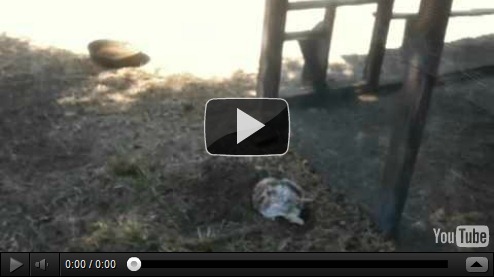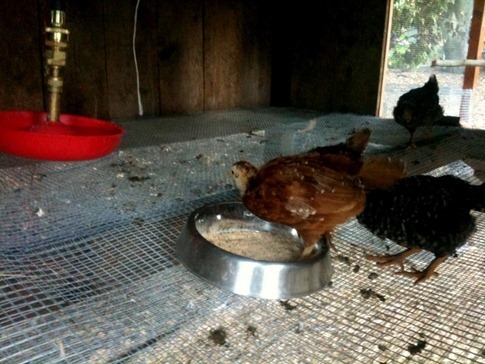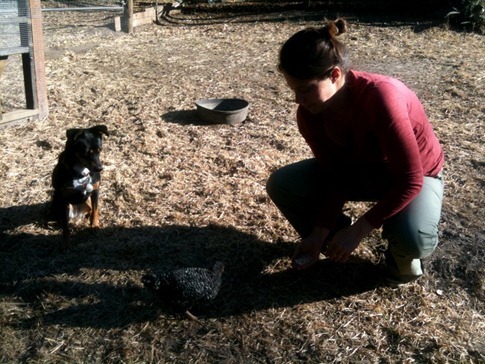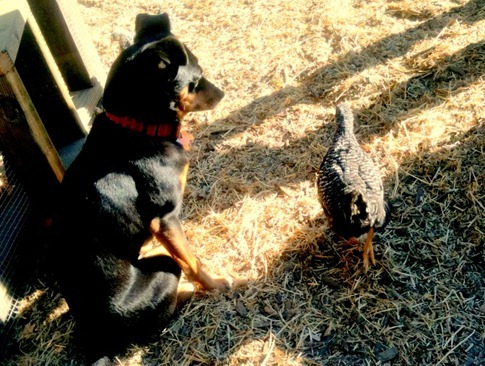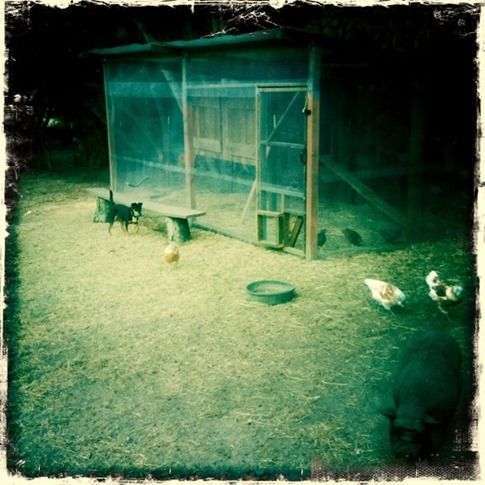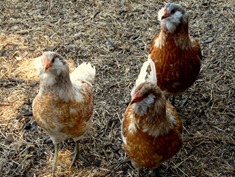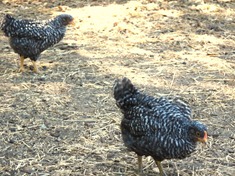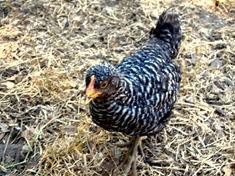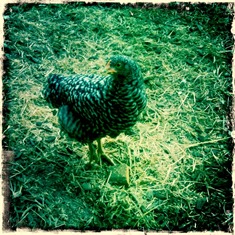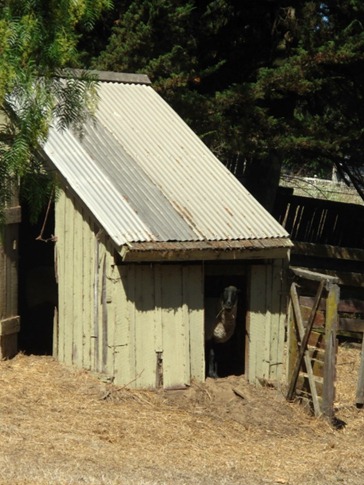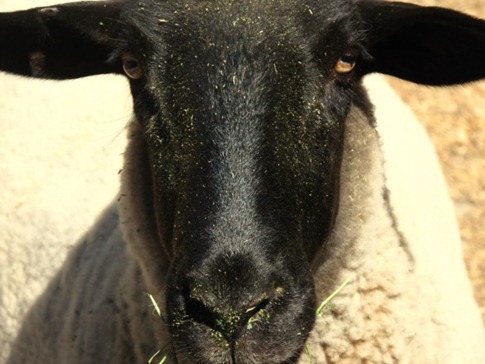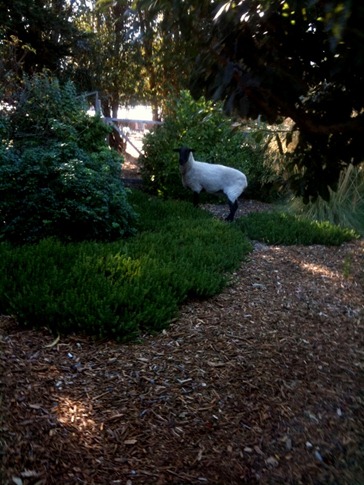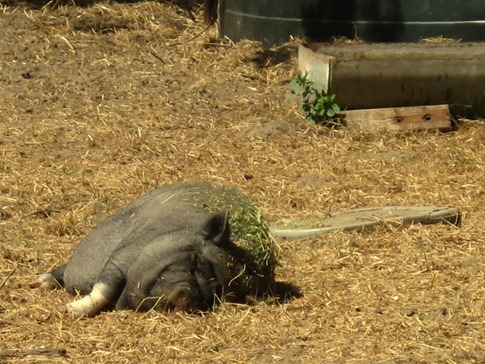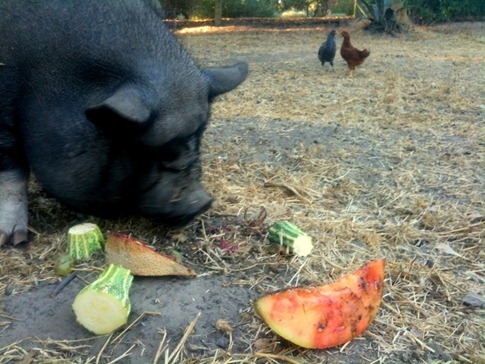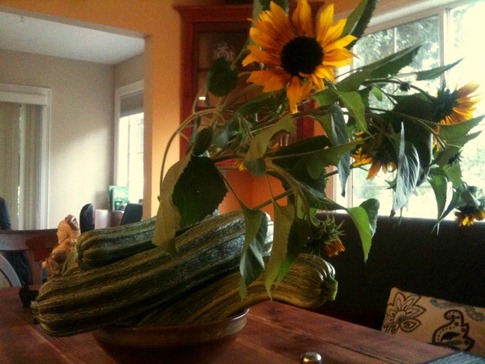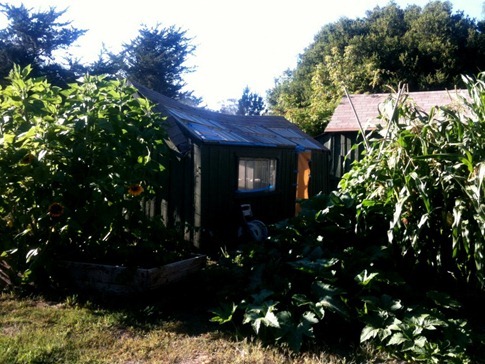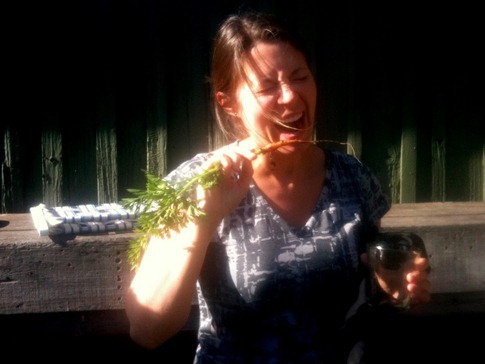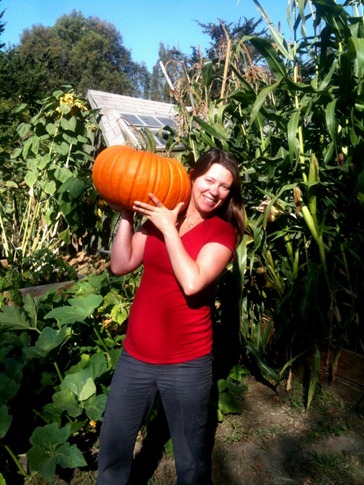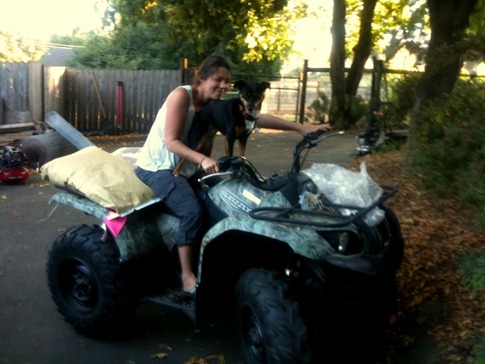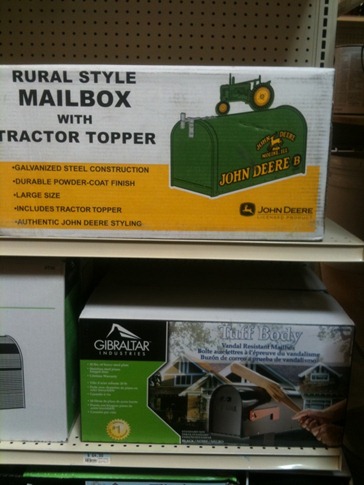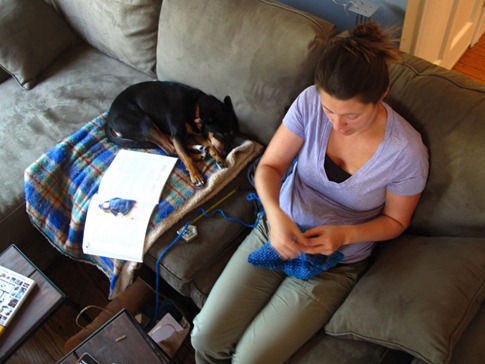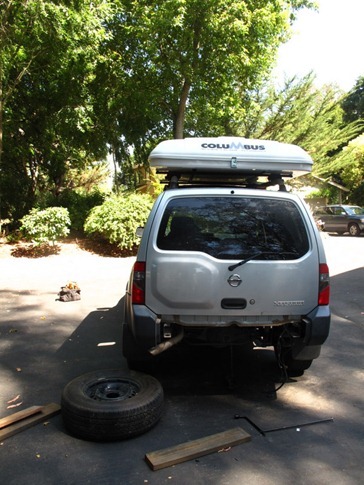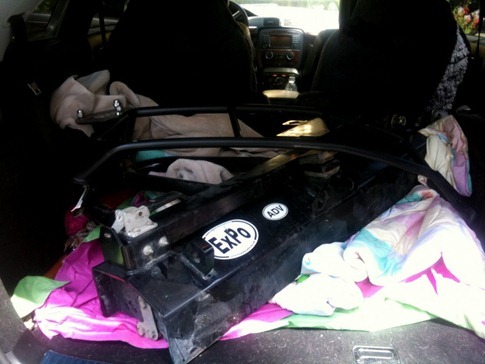I’m sure this is “Country Livin’ 101” but you never want to drive by the feed store in town with a cardboard box in the back of the car. If you do, you’re coming home with chicks. When we first started talking about having chickens, we did the math; Chickens lay about two eggs every three days, so four chickens would give us about a dozen eggs a week. This was going to be plenty (was the logical conclusion we should have drawn)…
We’d started out with five 12-week-old Ameraucanas figuring that they’d start laying at about 6 months of age, but now seeing them all alone in the huge coop, rationalized that we could easily accommodate three or four times that many chickens. After a week or so of confinement to get them familiar with their new home, we’d opened the small chicken-size door I’d built into the main entrance and encouraged the girls outside to explore the lower pasture. There’s something incredibly idyllic about watching chickens walking around freely, scratching the soil with their feet then leaning down to investigate what they’d uncovered. And while we’d come to realize that the 4 inch square spacing of our lower pasture fence allowed them to easily slip into the mulchy goldmine of the adjacent sun garden, after a nap in the shade of a bush, they’d soon slip back through to the pasture without causing any damage.
Additionally, we’d quickly discovered that our chicken-sized door was also pig-sized; As soon as the chickens would file out, Petunia would slip into the coop to root around amidst the food scraps and bedding. A 2x4 installed diagonally across the entrance did the trick, but for the next few mornings, Petunia would let out one of her trademark pitiful moans when, with only her nose through the door, her shoulders would hit the new barrier. You knew exactly what she was thinking; “What the hell?! I swear I could fit through here like only yesterday!”
Initially, we’d been worried about the hawks that regularly patrolled the sky and surveyed the pasture from high in the eucalyptus trees. Based on our primary source of knowledge on chicken/hawk interactions, Foghorn Leghorn cartoons, we assumed that once they reached a certain size, the hawks wouldn’t try anything. Still, for the first week we would walk/run out to the coop every time we’d hear the screeching call nearby.
And each time we’d reach the coop, we’d find that the chickens had seen the shadow or heard the call long before we had and were already back in the coop or under the protection of a bush. Now, when we wanted the chickens back inside, we’d call random “hawk drills” which consisted of us gliding around the pasture with arms extended doing our best shrieks as we herded the girls back through the small door of the coop. They typically saw through the rouse and diverted just before the coop door. (Either that or they are incredibly stupid and couldn’t find the door. Honestly, I’m leaning towards the latter explanation.).
We’d been to the back room of Rivertown Feed a few times, following the faint chorus of chirps until they grew into a cacophony. Along the left side of the 8 foot by 10 foot room were incubators, basically metal trays filled with what looked like Easter “Peeps” fresh out of the oven. As adorable as these tiny little puffballs were, this time we turned our attention to the stacked cages on the other side of the room containing slightly older birds. These were what our friend Finn refers to as the “awkward adolescent” birds, the ones you should picture when the supermodel on the late night talk show describes herself in high school before she “filled out.” Their long, slender necks had begun to extend from their compact bodies; they tromped around in too-big feet like they were wearing clown shoes; and developing feathers blemished their pure, fluffy down like a nightmare on the morning before prom.
Eager to populate the coop, we figured, hey, since we have the cardboard box in the back of the car, we might as well pick up a few more. We pointed to the ones we wanted in the crowded cages, and the 15-year-old sales girl, masterfully keeping our selections in sight, reached in to snatch them. $4.99 a head (beak?) later, and we were on the way home with 4 new additions, 2 Barred Plymouth Rocks and 2 Rhode Island Reds.
Between 4-6 weeks of age, baby chicks lose their downy undercoating and develop their feathers. Until their feathers are in, they need to be kept warm - 95 degrees in their first week and 5 degrees less every subsequent week. Our makeshift brooder was a cardboard box and a desk lamp set up in the downstairs shower, but we couldn’t resist the temptation to give them some outdoor time as well. Every morning, we’d carry their box out to the coop and, one by one, slip them under a cage I’d made from some leftover hardware mesh. There was quite a bit of interest in these new arrivals, both from the Ameracaunas and from Gorilla, so we thought it best to maintain some separation for a while.
Each night, we’d return the chicks to their shower/brooder for some warmth underneath the desk lamp.
Gradually, we started letting the little girls explore more around the coop and even venture outside. One, in particular, quickly discovered the wonders of the dust bath, an instinctive process of coating their skin with dust to control mites. Of course, to an outsider unfamiliar with chickens (read: us), it looks like your chicken just had a seizure and died.
We call this little girl “Pigpen.” She’s got an OCD dust bath problem. Watch all the way to the end of the video to see her get a little “therapy” from one of the elders. So that’s where the term “pecking order” comes from…
Here’s another dust bath video of one of the big girls. I was sure she was dead when I first approached the pasture gate and saw her.
Over the next couple weeks, the babies started filling out and got their full feathers. Once we felt like they could hold their own with the “Heathers,” we left them in the coop overnight with a powerful work light to huddle around if they got cold.
From the time we got the first chickens, Gorilla has been enthralled. Anytime we’d lose sight of her, we’d find her sitting at the edge of the coop, peering through the mesh. We needed to condition her to the chickens, and slowly, started letting her into the pasture while they were ranging, giving her a cautionary “Rillerrrrrr…” when she got too close. Before long – and after one solid smack on the nose when she jumped at one – she came to understand how close she could get. Unfortunately, the chickens didn’t get the memo, and though she would stop a few feet away, they would sometimes walk right up to her. You could see the conflict in her eyes between centuries of instinct and the fear of a reprimand, and she’d reflexively sit in a show of obedience. She would literally be trembling from the struggle as the chicken obliviously pecked at her feet.
Once it seemed like she had some control, we actually encouraged her to get a little closer, actually smell these forbidden little creatures. And with that, the mystery seemed to fade. Who knows if we’ll have a “slip up” at some point, but for now, we feel totally comfortable having her in the pasture – even alone – with the chickens.
Now even the babies are roaming the entire lower pasture, Petunia’s water bowl and food house being two of their favorite spots.
While the sheep will now approach us hoping for a handful of the “sweet feed,” a grain mixture covered in molasses, they still spend a lot of time in the shed, staking us out.
One afternoon, I left the gate open while walked back to the feed shed to get them some alfalfa. Eager for a treat, the ewe followed me right out. When I turned back towards her, she spooked and ran off into the sun garden. As I tried to direct her back towards the gate, I whipped out my cell phone and called Ann who was inside the house – something that happens quite a bit – and breathlessly “requested” that she come outside and help. Despite visions of chasing this sheep through the downtown streets of Petaluma, 10 minutes later, we had her back inside.
Petunia, mellow out. She insists on lurking underneath the basket of alfalfa we put out for the sheep and hence is constantly coated with a stringy green toupee on her otherwise flaky and hairless back.
But between extra zucchini from the garden and some leftover canteloupe, life’s pretty good for “Tounces.”
And speaking of zucchini, our plant just won’t seem to quit. We don’t pay attention for a couple days and we get more of these monsters. Ann’s been making zucchini pickles, zucchini bread, zucchini fritters… One Google search on what to do with an oversized zucchini suggested putting four tires on it and parking it in a red zone.
Yes, that’s a pretty pitiful looking (if delicious) carrot, but check out the prize-winning pumpkin!
Other than all that, we’re just kinda enjoying the rural life.
We still get down into the city to see friends about once a week and have been going a little more while arranging to re-rent our house in Bernal Heights. Once things settle down a little (hypothetical), we’d like to make some more time for farmer’s markets, farm tours, and restaurants around here and out towards the coast. We really feel like we’ve barely scratched the surface.
Still, with a baby on the way, the nesting instinct is strong. While Ann’s been taking up knitting – mostly motivated by one adorable picture of a baby in a little hooded “sack” – I’ve been able to sell most of the “expedition bits” off the truck, in the process meeting a nice outdoor photographer who bought the rear spare tire carrier and the ladder and a local guy who got us excited about keeping bees who took delivery of the rooftop tent for a friend in Portland.
It’s weird to see our bumper in the back of someone else’s car. It feels like we’re “dismantling” the trip to some extent, but it also feels like progress. We’re still amazed that at this time last year, we weren’t even married and hadn’t left for Panama. Remember this?
What a huge difference a year can make when your priorities become clear and you set your mind to making a change.

